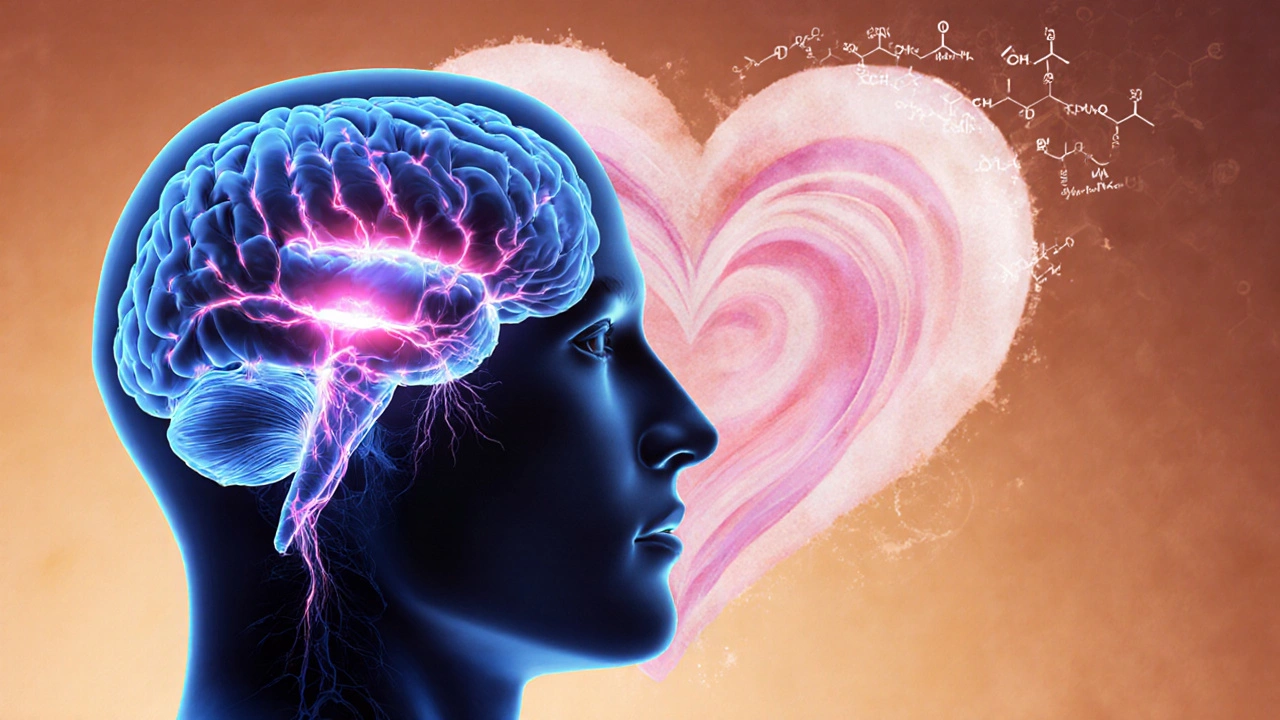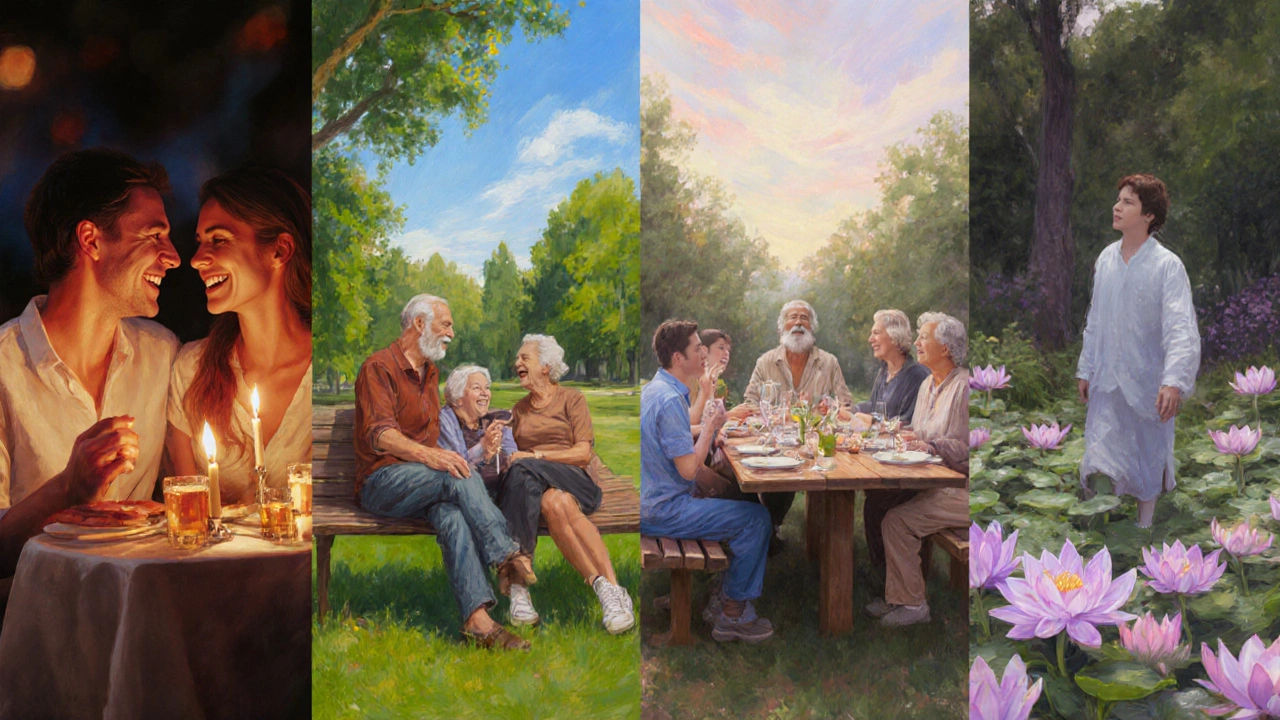
Love Type Explorer
Explore the four fundamental types of love and learn about their unique characteristics, feelings, and expressions.
Romantic Love
Passionate partnership
Platonic Love
Deep friendship
Familial Love
Family bonds
Self-Love
Personal wellbeing
Romantic Love
Primary Focus: Passionate partnership
Typical Feelings: Intense attraction, longing, excitement
Common Expressions: "I miss you," "I love you," candle-lit dates
Key Challenge: Maintaining intimacy over time
Love Quiz
Test your understanding of love types:
Quick Takeaways
- Love is a multifaceted emotion that blends biology, psychology, and culture.
- Four core types dominate: romantic, platonic, familial, and self‑love.
- Oxytocin and dopamine are the main chemicals that light up the brain when we feel love.
- Healthy love needs clear communication, mutual respect, and regular nurturing.
- Common traps - unrealistic expectations, neglect, and lack of boundaries - can be avoided with simple habits.
When we talk about love is a deep, complex emotion that binds people together through affection, care, and shared experience, the definition can feel both simple and endless. The love definition you hear in movies, poems, or science articles often highlights one side of a huge picture. In this guide we’ll break down what love really is, how the brain fuels it, the main flavors it comes in, and practical steps you can take to keep it thriving.
What Does Love Actually Mean?
At its core, love is an adaptive response that promotes bonding and cooperation. Evolutionary psychologists argue that love helped early humans survive by encouraging pair bonding for child‑rearing and forming supportive groups. Modern scholars add layers of meaning: love can be a feeling, a choice, a set of behaviors, or a mix of all three. It’s not just a warm fuzzy feeling; it’s also a commitment to act in someone’s best interest, even when the initial spark fades.
The Science Behind Love
Two chemicals dominate the love‑brain cocktail: Oxytocin and Dopamine. Oxytocin, often called the "cuddle hormone," spikes during physical touch, eye contact, and even when we share a secret. It reduces stress and builds trust. Dopamine, the reward neurotransmitter, lights up the brain’s pleasure centers, giving us that exhilarating "high" when we think about or are with someone we love.
Neuroscientist Helen Fisher’s research shows that romantic love activates the ventral tegmental area (VTA), a region linked to motivation and reward. As love matures, activity shifts toward brain areas tied to calmness and attachment, like the ventral striatum. This shift explains why early‑stage crushes feel like fireworks, while long‑term partnerships feel like a steady warm blanket.
Attachment Theory, originally proposed by John Bowlby, adds another layer. It suggests that early caregiver bonds shape our adult love styles - secure, anxious, or avoidant. Understanding your attachment pattern can clarify why you react the way you do in relationships.

Core Types of Love
Scientists and philosophers often group love into four primary categories. Each has its own emotional fingerprint, typical behaviors, and challenges.
| Type | Primary Focus | Typical Feelings | Common Expressions | Key Challenge |
|---|---|---|---|---|
| Romantic Love | Passionate partnership | Intense attraction, longing, excitement | “I miss you,” “I love you,” candle‑lit dates | Maintaining intimacy over time |
| Platonic Love | Deep friendship | Trust, loyalty, comfort | “You’re my best friend,” “I’ve got your back” | Boundaries vs. romantic expectations |
| Familial Love | Family bonds | Unconditional care, responsibility | “Family first,” “I’ll always be there for you” | Managing obligations and independence |
| Self‑Love | Personal wellbeing | Acceptance, self‑compassion | “I deserve good things,” “I’m enough” | Overcoming self‑criticism |
Love Across Cultures
Love isn’t a one‑size‑fits‑all. In Japan, the concept of "amae" captures a sweet‑spot of dependence and trust that fuels both family and romantic ties. In Mediterranean cultures, expressive affection - public hugs, passionate conversations - is a norm. Meanwhile, many Indigenous communities view love as a communal responsibility, where caring for the group outweighs individual romance.
These cultural lenses shape how people express love, what rituals they follow, and even which type of love they prioritize. Recognizing cultural nuance helps you avoid misreading signals when interacting with people from different backgrounds.
How to Nurture Love in Your Life
Whether you’re building a new romance, deepening a friendship, or practicing self‑care, the same basic habits apply.
- Communicate regularly. Small check‑ins (“How was your day?”) keep the connection alive.
- Practice gratitude. Voice appreciation for specific actions (“Thanks for cooking dinner”).
- Share physical touch. A hug, hand‑hold, or gentle pat releases oxytocin.
- Invest time together. Joint activities build shared memories and reinforce dopamine pathways.
- Set healthy boundaries. Knowing what you can give and what you need protects both parties.
- Reflect on your attachment style. If you notice anxiety or avoidance, consider therapy or journaling to re‑wire patterns.
- Prioritize self‑love. A well‑fed mind and body (sleep, nutrition, hobbies) makes you a better partner for others.
Try a weekly "love audit" - a quick review of how you’re showing up for each relationship. Ask yourself: Did I listen actively? Did I express appreciation? Did I respect boundaries? Small tweaks add up.
Common Pitfalls and How to Dodge Them
Even the most caring people stumble. Here are three frequent traps and quick fixes.
- Unrealistic expectations. Media paints love as constant fireworks. Counteract by reminding yourself that love also includes mundane moments.
- Neglecting self‑care. When you run on empty, you can’t give love fully. Schedule "me time" just as you would a date night.
- Lack of clear boundaries. Ambiguity breeds resentment. Use "I" statements to voice limits (“I feel overwhelmed when we text late at night”).

Mini FAQ
Is love a feeling or a choice?
Both. The initial spark is a feeling driven by dopamine and oxytocin, but lasting love requires daily choices to act kindly, communicate openly, and respect boundaries.
Can you feel romantic love for more than one person at once?
Yes. Psychologists call this "polyamory," where individuals maintain consensual romantic relationships with multiple partners, each based on trust and communication.
How does self‑love affect other relationships?
When you value yourself, you set healthier boundaries, avoid codependency, and bring confidence into partnerships, which generally improves relationship quality.
What role does culture play in defining love?
Culture shapes love expressions, rituals, and expectations. For instance, some societies celebrate public displays of affection, while others view love as a private, duty‑driven bond.
Can love disappear, or does it just change?
Love rarely vanishes outright. It usually transforms-from passionate romance to companionate partnership or from intense friendship to respectful distance-depending on life stages and mutual effort.
Understanding love as a blend of biology, psychology, and culture equips you to enjoy richer connections. Keep experimenting with the habits above, stay curious about your own patterns, and remember that love, like any skill, gets better with practice.